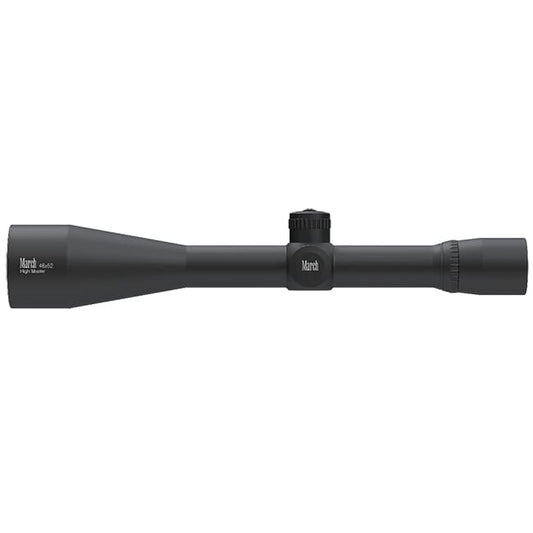

The March High Master 48x52mm riflescope offers fixed 48x magnification for precise target detail, making it ideal for serious Benchrest shooters. Its design prevents unintentional shifts in the point of impact, ensuring consistent performance. Constructed on a robust 30mm main tube, it features lenses made from Super Extra-Low Dispersion and High-Refractive optical glass that enhance clarity and color fidelity. The 1/8 MOA adjustments allow for precise aiming, making this scope a powerful tool for long-range shooting.
With its side focus parallax adjustment from 10 yards to infinity, users can achieve optimal clarity at varying distances. The matte black finish and capped turrets provide a professional appearance while ensuring durability and ease of use in competitive environments. The March High Master 48x52mm riflescope is a comprehensive solution for those seeking high-performance optics for their competitive shooting needs.
Features:
- FIXED 48X MAGNIFICATION for extreme detail at long distances.
- SUPER EXTRA-LOW DISPERSION GLASS enhances clarity and color accuracy.
- 1/8 MOA ADJUSTMENTS allow for precise and repeatable aiming.
- 30MM MAIN TUBE provides increased durability and mounting options.
- SIDED FOCUS PARALLAX ADJUSTMENT ensures optimal targeting from 10 yards to infinity.
- CAP TURRETS protect against accidental adjustments during use.
- MATTE BLACK FINISH offers a professional look while minimizing glare.
- LIGHTWEIGHT DESIGN makes it suitable for various shooting setups.
Technical Specifications
| Specification | Details |
|---|---|
| Magnification | 48x |
| Objective Lens Diameter | 52mm |
| Main Tube Diameter | 30mm |
| Click Value | 1/8 MOA |
| Eye Relief | 2.6-3.19in |
| Field of View | 2.7ft at 100yds |
| Weight | 22.75oz |
| Length | 14.57" |
What's in the Box?
- Riflescope
- User manual
- Lens covers
- Padded case
Customer Reviews
"The clarity and precision of this scope are unmatched at this price point!"
"Perfect for my competitive shooting needs—highly recommend."
FAQ
1. How does the side focus parallax adjustment work?
The side focus allows you to adjust the parallax setting easily, ensuring that your reticle remains on target at various distances, providing a clearer image and better accuracy.
2. Is this riflescope suitable for low-light conditions?
While designed for bright conditions, the high-quality optical glass does provide decent visibility in low-light situations, making it a versatile choice for various shooting scenarios.
3. Can this scope withstand harsh weather conditions?
Yes, the March High Master is constructed to be fog-proof and waterproof, making it suitable for use in various environmental conditions.
4. What type of mounting is required?
This riflescope requires a 30mm mount, compatible with standard mounting systems used by most firearms.
5. How does it compare to other brands?
The March High Master is known for its exceptional clarity and precision, often regarded as a premium choice compared to other brands like Leupold or Nightforce for serious marksmen.
Similar Models
Looking for more options? Explore our March riflescopes, including the March 1-8x24mm for versatile shooting and the March 10-60x52mm for extreme long-range precision. Each model comes with advanced features tailored for serious shooters.
You May Also Like
Here’s some of our most similar products people are buying. Click to discover trending style.









